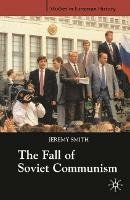The Fall of Soviet Communism, 1986-1991
The fall of communism and the break-up of the Soviet Union into 15 independent states in December 1991 was one of the most significant events of the twentieth century. In the last years of Soviet rule, images of mass protests on the streets of Moscow, Tbilisi and Vilnius, bloodshed in Baku, striking miners, Mikhail Gorbachev wooing the West, and Boris Yeltsin defiantly mounting a tank in front of the White House building in Moscow, shattered all of the old certainties about the seemingly unbreakable communist system. Gorbachev and Yeltsin were the dominant figures in this process, but non-Russian national movements, workers, intellectuals, and international developments all had roles to play. Jeremy Smith presents the dramatic events of 1985-91 in a clear and succinct form, setting out a variety of interpretations for the demise of communism in the Soviet Union, and suggesting new approaches to answering the unresolved question of why it happened. Smith discusses the long-term and short-term factors behind the extraordinary collapse, assessing the impact of economic crisis, nationalism, personalities and democratization in the process.
-
Autore:
-
Editore:
-
Collana:Studies in European History
-
Anno:2005
-
Rilegatura:Paperback / softback
-
Pagine:144 p.
Le schede prodotto sono aggiornate in conformità al Regolamento UE 988/2023. Laddove ci fossero taluni dati non disponibili per ragioni indipendenti da Feltrinelli, vi informiamo che stiamo compiendo ogni ragionevole sforzo per inserirli. Vi invitiamo a controllare periodicamente il sito www.lafeltrinelli.it per eventuali novità e aggiornamenti.
Per le vendite di prodotti da terze parti, ciascun venditore si assume la piena e diretta responsabilità per la commercializzazione del prodotto e per la sua conformità al Regolamento UE 988/2023, nonché alle normative nazionali ed europee vigenti.
Per informazioni sulla sicurezza dei prodotti, contattare productsafety@feltrinelli.it



